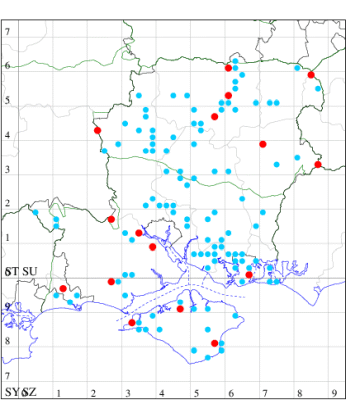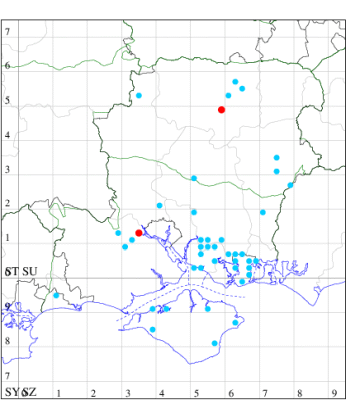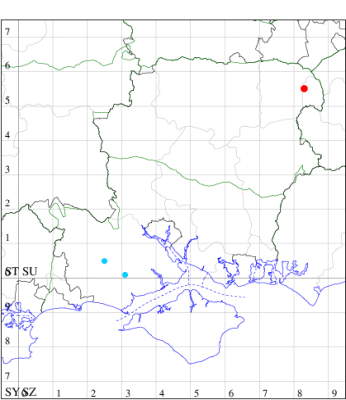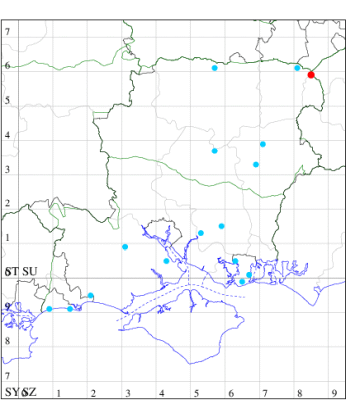2022 Annual Report for: Parametriotidae / Parametriotinae
For species seen in 2022 that had less than or equal to 100 records, full details are included; for more common species, the earliest, latest and highest count by vice-county are shown. The narrative for each species is taken from the main Hantsmoths website, and it is possible that some information on abundance and occurrence can get out of date, as it is impossible to keep up with all changes; however it should give a good introduction to each species. The tables in each species account summarise the previous status, and that for the current year.
For the maps, all records prior to 2022 are shown by a blue dot (the larger the dot, the more recent), with the current year's records shown in red. As previous records are superimposed on any report for 2022, new sites have greater emphasis (i.e. will show as 'more red').
In the species accounts, an asterisk next to a location indicates a new 10km square record; earliest ever dates are highlighted in orange, and latest ever in red. Initials in the species accounts refer to the recorders listed here. Please get in touch if you identify any omissions or errors, in particular if you have records that have yet to be submitted. Details of how to submit records can be found here.
39.001 [B&F: 0905] Blastodacna hellerella (Duponchel, 1838) - Common
Common in hedgerows, woodland edges and scrub throughout the British Isles, but not in northern Scotland, and rare in Ireland. Recorded locally in Hampshire and on the Isle of Wight, but probably under-recorded. Wingspan 10-11 mm. The species differs from Apple Pith Moth B. atra by its pure white markings on the forewing and the absence of yellow-ochreous scales at the base of the dorsum. Larva feeds within berries of Hawthorn, over-wintering as a pupa.
Records prior to 2022
| Vice County | #Records | #Individuals | First Record | Last Record |
|---|---|---|---|---|
| 10 | 51 | 58 | 1930 | 2021 |
| 11 | 374 | 410 | 1972 | 2021 |
| 12 | 157 | 187 | 1971 | 2021 |
2022 records
| Vice County | #Records | #Individuals | Max Quantity |
|---|---|---|---|
| 10 | 7 | 7 | 1 |
| 11 | 6 | 4 | 1 |
| 12 | 13 | 14 | 2 |

Records by year
Records by week (adult)
Records by week (larval)
Record Details
VC10: Totland, one, 1 x female gen. det, 26 Jun (RTer); Parkhurst Forest, one, 02 Jul; Shanklin, one, 06 Jun; one, 05 Jul; one, 09 Jul; one, 11 Jul; one, 12 Jul (IOu);
VC11: Wicksmoor Farm, Plaitford Common, NF*, present, 13 Jul (RBW); Marchwood, present, 08 Jul (CTha); Totton, one, 17 Jun (LHan); Portsmouth, one, 25 Jun (IRT); Hurn, one, 03 Jul (MJef); Sway, one, 16 Jun (SKee);
VC12: Cholderton, one, 19 Jul (TJN); North Waltham, one, 16 Jun; one, 18 Jul (AJon); Basingstoke, two, 12 Jul; one, 19 Jul (MJW); Pamber Forest, one, 11 Jul (GJD); Alton, one, to artificial light, 29 Jun; one, 06 Jul (DBO); Hammer Vale, Woolmer, one, 07 Jul (ASwa); Blackwater, one, 16 Jun; one, 01 Jul; one, 11 Jul; one, 12 Jul (BGD)
39.003 [B&F: 0904] Spuleria flavicaput (Haworth, 1828) - Local
Local in hedgerows, woodland edges, scrub and gardens throughout much of the British Isles, but not in northern Scotland. In Hampshire and on the Isle of Wight local and evidently rather uncommon, with the majority of records in the south-east of the county, perhaps overlooked elsewhere. Wingspan 12-14 mm. Distinctive combination of bright yellow head and raised scale tufts one-third and two-thirds of the way along the forewing. Larva feeds within bark of Hawthorn and Midland Hawthorn, over-wintering as a pupa.
Records prior to 2022
| Vice County | #Records | #Individuals | First Record | Last Record |
|---|---|---|---|---|
| 10 | 6 | 4 | 1903 | 2014 |
| 11 | 58 | 89 | 1973 | 2021 |
| 12 | 9 | 22 | 1973 | 2016 |
2022 records
| Vice County | #Records | #Individuals | Max Quantity |
|---|---|---|---|
| 11 | 2 | 2 | 1 |
| 12 | 1 | 1 | 1 |

Records by year
Records by week (adult)
Records by week (larval)
Record Details
VC11: Totton, one, 08 Jul; one, 12 Jul (LHan);
VC12: Basingstoke, one, 15 Jun (GAH)
39.004 [B&F: 0907] Dystebenna stephensi (Stainton, 1849) - Nationally Scarce A
Nationally scarce (Na) in ancient oak woodland and parkland in parts of south-eastern England, Herefordshire and Derbyshire. In Hampshire restricted to the New Forest, where there have been few recent records: one at Burley New Inclosure in 1999, one in Roydon Woods in 1992. Not recorded from the Isle of Wight to date. Wingspan 8-10.5 mm. Voucher specimen should be retained for confirmation of identification. Larva feeds within bark of Oak, favouring mature trees, and over-wintering as a pupa.
Records prior to 2022
| Vice County | #Records | #Individuals | First Record | Last Record |
|---|---|---|---|---|
| 11 | 2 | 2 | 1992 | 1999 |
2022 records
| Vice County | #Records | #Individuals | Max Quantity |
|---|---|---|---|
| 12 | 1 | 1 | 1 |

Records by year
Records by week (adult)
Records by week (larval)
Record Details
VC12: New Vice-county Record: Fleet Pond*, one, 01 Aug (MHals)
39.005 [B&F: 0903] Chrysoclista linneella (Clerck, 1759) - Nationally Scarce B
Nationally scarce (Nb) in lime woodland, parkland, urban areas and on roadside verges in parts of southern England and southern Wales, with records north to Yorkshire. In Hampshire recorded on the coast at Bournemouth, Christchurch, Southampton and Southsea, where regular and frequent, but recorded infrequently further inland. Not recorded from the Isle of Wight to date. Wingspan 10-13 mm. Differs from C. lathamella in the forewing, which has the orange ground colour undivided, by the narrow dark edging of the basal part of the costa and by the lack of a patch of erect dark scales in the second dorsal spot (MBGBI Vol 4 part 1). Larva feeds within bark of Common Lime, Small-leaved Lime and Large-leaved Lime.
Records prior to 2022
| Vice County | #Records | #Individuals | First Record | Last Record |
|---|---|---|---|---|
| 11 | 30 | 28 | 1982 | 2020 |
| 12 | 6 | 5 | 1975 | 2020 |
2022 records
| Vice County | #Records | #Individuals | Max Quantity |
|---|---|---|---|
| 12 | 1 | 1 | 1 |

Records by year
Records by week (adult)
Records by week (larval)
Record Details
VC12: Blackwater*, one, 12 Jul (BGD)